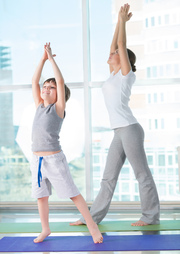5 Benefits of Doing Yoga with Your Child
We all know about the many benefits of performing yoga alone. A scheduled yoga session carves time away from your day to focus on breath, movement, and relaxation, allowing you to destress and rejuvenate. While practicing yoga alone can be immensely beneficial, you can also partake in yoga with a partner, best friend, or child.
Practicing yoga with your child can give you both time to prioritize tranquility and bond with one another. Beyond yoga’s physical and mental health benefits, engaging in yoga with your child can help you forge a deeper emotional connection together and cultivate a shared practice of togetherness without the influence of technology or cell phones.
Here are 5 key benefits of doing yoga with your child.
Physical Fitness and Flexibility
Though yoga is often performed by adults, children can also enhance their flexibility and strength through various poses and flows. In performing yoga with a parent, children can improve their balance, build muscle strength, and advance their flexibility, all with the guidance of a mom or dad.
These practices support children’s physical development and encourage key bodily movement at a time when less than a quarter of children (24%) participate in one hour of physical activity each day. By exercising and practicing yoga with your child, you are encouraging them to develop lasting habits around fitness and exercise, which will benefit them for years to come.

Enhanced Concentration and Focus
In a time when many children (and adults) are distracted by cell phones and video games, solidifying the ability to focus and concentrate is key. Scheduled yoga practice, especially a session without screens, is a great way to step away from technology and focus on the present. Yoga requires participants to pay attention to their breath as they move into and hold different stretches and positions.
In staying still in these stretches and focusing on how the air moves through your body, you and your child are both able to improve your attention span and feel the sensations around you. By practicing yoga with your child, you both have a precious opportunity to embrace mindfulness and accept a reprieve from the distraction of technology, at least for a time. By making yoga with your child a habit, you’re fostering key skills in patience and focus, which they can use to succeed in the classroom or other extracurricular activities.
Stress Relief and Emotional Well-Being
Both children and adults encounter stress in their lives, but adults, with their long history of encountering and overcoming adversities, are often better equipped to handle the emotional turmoil that comes along with it. Though academic pressures and school drama may seem trivial to parents, to a child that is only just learning how to regulate their emotions, these events can be extremely challenging.

Yoga encourages relaxation through deep breathing and stretching, providing children with a safe outlet to release tension and process emotions. Additionally, by practicing yoga as a family or encouraging your child to partake in BFF yoga time with one of their friends, you are carving out a time for you and your child to meditate and process emotions fostering a safe space and encouraging open communication.
Bonding and Communication
Finding time in your busy schedule to genuinely bond and engage with your child can be difficult. Between work, school, extracurriculars, and other household tasks, it can be increasingly difficult to spend time alone with your child, especially with the influence of technology and social media.
By setting aside time for yoga, however, both parent and child gain genuine 1:1 time together to bond outside of the everyday routine. This shared experience encourages healthy connections outside of yoga as well, opening the door to meaningful discussions and more open communication.
Body Positivity and Self-Love
Yoga is deeply connected to gratitude for the body. During each practice, it’s important to take time to thank yourself both for taking the time to yourself engage in yoga and also thank your body for all the work it has done. By emphasizing gratitude for the body at a young age, children learn early that they should love their body and properly appreciate everything they accomplish with it.
In yoga, your body’s capabilities and achievements are celebrated instead of your appearance. In flowing through poses with your child, you can emphasize the skills of attuning to your body and embracing all its facets, even those that make yoga more challenging. This positive reinforcement can help children avoid the self-criticism and self-consciousness that becomes so common as they age and learn a more balanced perspective of body image.
The Basic Principles of Yoga for Children
Your child may be too young to understand the full complexity and principles of yoga when you first start practicing together. This is okay! When introducing your child to yoga, you only need to introduce them to the basic few principles:
Exercises (Asanas): The most visible aspect of yoga is the movement through poses. Teaching your child to follow your movements and to stop when there is pain or discomfort is one of the most important yogi principles.
Breathing (Pranayama): The backbone of yoga. You must teach your child to focus on their breath and try to stay connected to their breathing throughout the session.
Relaxation (Pratyahara), Meditation (Dhyana) & Concentration (Dharana): A child’s mind is more wont to wander than any adult’s, but encouraging your child to focus on the present will allow them to embrace the relaxation.
Union (Samadhi) & Discipline (Yamas): After you are done practicing yoga, you should point out to your child how yoga and meditation can change other aspects of their life. Yoga does not stop when the session is done.
Setting aside time for yoga in your family can provide many benefits for both parent and child. From promoting physical health to personal body image, yoga provides a great way to holistically tend to your child’s development and promote emotional bonding. Whether you’ve each practiced yoga before, or you’re both trying something new, yoga with your child will encourage enhanced well-being in you both and create memories that will last for years.
Incorporating modern practices, such as online yoga, can complement your traditional routines with your child while providing flexibility and convenience. Whether you’re new to yoga or have practiced for years, exploring diverse methods can enhance your shared experiences and strengthen the benefits gained from this mindful activity. Online platforms offer structured programs that align with various skill levels and schedules, making it easier to commit to the practice together.
Additional Resources
Incorporating modern practices, such as online yoga, can complement your traditional routines with your child while providing flexibility and convenience. Whether you’re new to yoga or have practiced for years, exploring diverse methods can enhance your shared experiences and strengthen the benefits gained from this mindful activity. Online platforms offer structured programs that align with various skill levels and schedules, making it easier to commit to the practice together.








 Author bio: Cora Gold is the Editor-in-Chief of women’s lifestyle magazine,
Author bio: Cora Gold is the Editor-in-Chief of women’s lifestyle magazine, 


